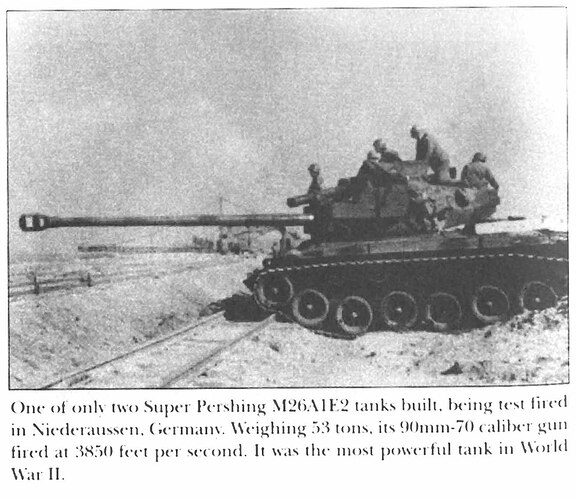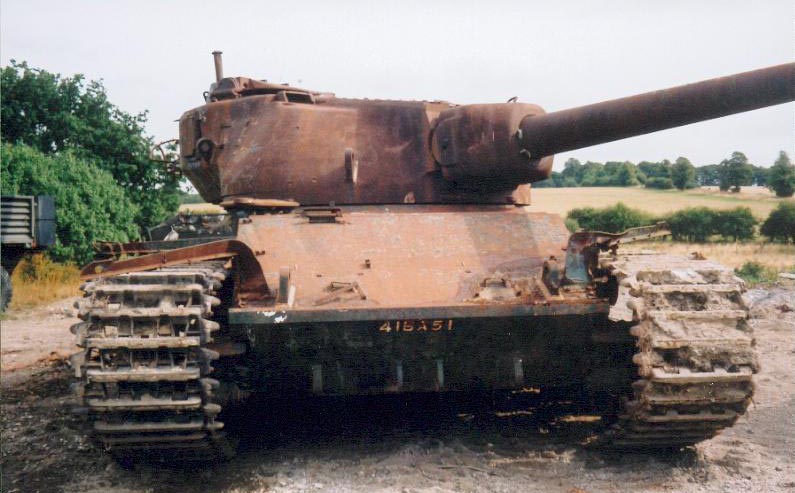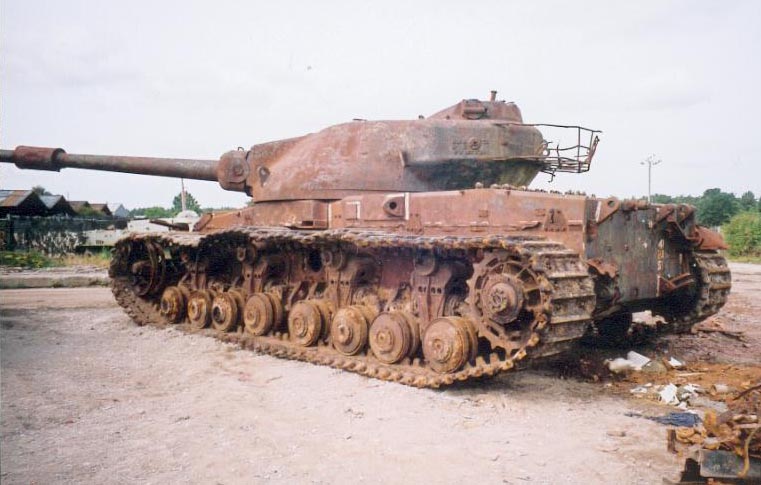My compliments to you Jeff - it’s beautiful 
Very interesting, I thought the super-Pershing was just a concept vehicle never realised it saw actual combat, until I did a quick search and found the following.
[i]DUEL AT DESSAU
on April 21, 1945
Only three days before the 3rd Armored Division’s final combat action of WWII, a Super Pershing of the 33rd Armored Regiment met and defeated the most powerful and most heavily armored German tank of the war - the legendary 77-ton King Tiger, also known as the Tiger II or Tiger Royal. It would be the first and only meeting between a King Tiger and the Super Pershing, a modified standard M26 Pershing weighing 7 tons heavier at 53 tons - an almost “secret” tank that, to this day, remains largely an enigma to military historians.
Only two Super Pershings were ever built, and the 3AD had the only one in the European Theater - an experimental version with its remarkably long barrel. Arriving very late in the war (March, 1945), it was field tested and modified inside Germany and subsequently saw about ten days of actual combat action, beginning several days after the Battle of Paderborn and ending with the Battle of Dessau near the Elbe River.
The Super Pershing (aka T26E4-1) was equipped with a new long-barreled T15E1 90mm gun (70 calibers) that was designed to out-perform the German high-velocity 88mm on the King Tiger. In testing, this new U.S. gun had successfully penetrated 8.5 inches of armor at 1,000 yards at 30 degrees. Even more remarkable, it had penetrated 13 inches of armor at 100 yards. The special 90mm ammunition had produced a muzzle velocity of 3,850 feet per second, or some 600 feet per second faster than the 88mm of the King Tiger. The new 90mm round also proved to have superior range and accuracy over the previous version.
Army ordnance technicians (in the U.S. and Europe) had been anxious about getting the new tank into combat, hoping to match it against a King Tiger. But by April, 1945, German armor west of Berlin had dramatically thinned out, not to mention an extreme shortage of fuel, and the odds of spotting the monster German tank were slim. But in Dessau on April 21, “luck” would befall the Super Pershing crew commanded by SSgt Joe Maduri, a veteran 3AD tanker in his tenth straight month of combat.
The 3AD had begun a four-pronged attack on the city, which was heavily defended. Division armor were finally able to enter the city slowly after numerous concrete tank barriers were destroyed. With 3AD tanks fanning out, and 36th Infantry riflemen following, the Super Pershing reached an intersection and began to round a corner to its right. Unknown to its crew, a King Tiger had apparently been waiting in ambush at a distance of two blocks or roughly 600 yards away, and in the same direction that the Americans were turning into.
At this distance, easily within its capability, the Tiger fired at the Super Pershing. But its infamous high-velocity 88mm shell, of the type that had destroyed so many American tanks and vehicles during the war, went high and was not even close. Gunner Cpl John “Jack” Irwin, only 18 years old, responded almost instantly with a round that struck the Tiger’s huge angled glasis, or front plate. But the shot, a non-armor-piercing high explosive (HE) shell, had no effect. Ricocheting off the armor, it shot skyward and exploded harmlessly. The Super Pershing had been loaded with an HE only because Irwin had been expecting urban targets, such as buildings, personnel, and light anti-tank guns. “AP!”, he shouted to his loader “Pete,” which meant an armor-piercing shell would be next.
Maduri and crew then felt a concussion or thud on the turret. It was never known if this shot came from the Tiger, or from some other anti-tank weapon. In any case, no serious damage was done - probably a lucky glancing impact. In the next instant, Irwin aimed and fired a second time, just as the royal monster was moving forward and raising up over a pile of rubble. The 90mm AP round penetrated the Tiger’s underbelly, apparently striking the ammo well and resulting in a tremendous explosion that blew its turret loose. With near certainty, the entire crew was killed.
But there was no time to examine their “trophy.” A battle was raging, and the Super Pershing continued down the street, passing the lifeless and burning King Tiger. Tough fighting still lay ahead, as German bazooka, Panzerfaust, and machine-gun fire came from windows and doorways.
The encounter with the King Tiger had been “short and sweet,” lasting less than twenty seconds. It may not have been the titanic “slug fest” that could have occurred on an open field, but it was an overwhelming victory for the quick-reacting Super Pershing crew. The battle for Dessau would end completely on the following day, but not without the Super Pershing destroying another German heavy tank (believed to be a 50-ton Panther Mark V) with two shots. The first disabling its drive sprocket, and the second round completely penetrating the tank’s side armor. That apparently set off an internal blast, again probably from stored ammo. And, still in Dessau, that was followed by Maduri and crew forcing the commander of a German medium tank to surrender without firing a shot. For the German crew, out of ammo for their main gun, the intimidating “look” of that long-barrel 90mm gun that must have destroyed any remaining will to fight or flee.
[Note: Sources include the book Spearhead in the West (1946 edition); the book Death Traps by Belton Cooper; and the book Another River, Another Town and personal writings by John P. Irwin.][/i]
Thought you might like seeing these photos I found today…

Nice… That lucky shot was really, really lucky. The gunner in the Tiger must have been elated.
The name of the “British M103” was Conqueror, it also had an 120mm gun. A tank destroyer with 183mm gun was projected, but not produced. The Conqueror was phased out as soon as the Chieftain (also 120mm) was on the horizon. This example has been used for target practice.
I saw one at a museum in England, it´s 4m wide and left a greater visual impression the the Jagdtiger.
The Soviets were also ready to “go one bigger” if the need arose, contemplating more powerful 122mm and naval 130mm weapons for their ISU´s in a tank hunting role.
M-26 tank losses in World War II - three total - two were knocked out (one by a Tiger tank and one by artillery fire), but they were subsequently repaired and returned to service. A third tank was knocked out by a Nashorn tank destroyer and caught fire, but the whole crew was able to bail out before the fire set off the ammo stowed under the turret. It suffered a completely burned out turret as a result and it was determined that it would take too long to repair. So the tank was cannibalized for parts and became the only total Pershing loss in WWII of the original shipment of 20 tanks.
M26 Pershing - Combat history
http://www.experiencefestival.com/a/M26_Pershing_-_Combat_history/id/5264237
http://en.wikipedia.org/wiki/M26_Pershing#World_War_II
The first Pershing loss was on the 28th February to a Tiger but it was recovered and put back into operation…
…In the first engagement with the M26 by the 3rd Armored Division, Cooper writes that the M26 managed to catch two Tigers and one Mark IV tank by surprise from a flanking position. The M26 engaged the tanks from a range of about 1000 yards (1 km), and knocked them out…
…Two M26A1E2 tanks were built during the Second World War. One of these made it to the ETO, assigned to the 3rd Armored Division. This experimental version of the Pershing, sometimes referred to as “Super Pershing” (as are other upgunned Pershing variants), had the 90 mm/70 caliber T15E1 high-velocity gun that threw a projectile at 3,850 ft/s (1,173 m/s). On April 4, 1945 near Dessau, the “Super Pershing” destroyed one King Tiger by striking its underbelly and knocked out another tank, probably a Panther, with a shot to its flank [2]. However, that was its only known combat engagement. Thus, the full capabilities of the T15E1 90 mm main gun were never demonstrated.
Pershing vs. Tiger?
http://www.ww2f.com/151499-post6.html
The first loss came on 25 February to 3rd Armored when the Pershing assigned to F Company 33rd Armd. Reg. was knocked out by a Tiger from about 100 yards. The first hit penetrated the turret through the coax MG port and killed both the gunner and loader. The second hit shot off the muzzle brake setting of the 90mm round in the gun and destroying the tube. The third hit glanced off the right side of the turret and knocked off the cuploa hatch which was open. The surviving crew backed away, getting the tank stuck in a pile of building debris, abandoning the tank.
[b]This tank was nicknamed Fireball . This tank was repaired, the 90mm being replaced from one on an M 36 returning to service on 4 March 45.
One tank of the 14th Armored Battalion A Company lost one Pershing when it was struck by heavy artillery fire on 1 March 45. This tank was subsequently repaired and returned to service on 7 March.
Those are the only two losses, well sort of anyway, of Pershings in the ETO. So, one did get knocked out by a Tiger (which was subsequently destroyed in the action by other tanks present) and one by artillery fire.[/b]
See United States Tanks in World War II, George Forty and Pershing, a History of the Medium Tank T20 Series, Richard P. Hunnicutt
Pershing vs. Tiger?
http://www.ww2f.com/151500-post7.html
Hmmmm… now this is slightly confusing. The 3ad little website I found clearly states that one of the Pershings WAS knocked out by a Nashorn.
http://3ad.com/history/wwll/article....hing.ko.2a.htm
Has a couple photos of the ko’ed tank, and-Quote:
3rd Armored T-26E3 Pershing, serial number 25, registration number 30119835, was assigned to Company H, 3rd Battalion, 33rd Armored Regiment, Taskforce Lovelady, Combat Command B.Pershing number 25 was knocked out on 6 Mar 45 from the range of 300 yards by a self-propelled German Nashorn tank destroyer during the fighting in the town of Niehl, Germany north of Cologne. The Nashorn hit Pershing number 25 with its 88mm gun on the lower left front. The armor-piercing round penetrated the armor and took a path between the driver’s legs and under the turret where it started a fire. The whole crew was able to bail out before the fire set off the ammo stowed under the turret.
Pershing number 25 suffered a completely burned out turret as a result and it was determined that it would take too long to repair. So the tank was cannibalized for parts and became the only total Pershing loss in WWII of the original shipment of 20 tanks.
Sources listed-
Research Sources:
After The Battle magazine, issue #104
Pershing: A History Of The Medium Tank T-20 Series by Hunnicut.
Spearhead In The West published by the 3rd Armored Division, 1945
M-26/M-46 Pershing Tank 1943-1953 by ZalogaThis info is from the “official” website of the Third Armored Division…

M26-03-X
From: “German Tanks of World War II in Action”, by George Forty, Blandford Press, 1988, (p 130)
Wow, imagine one of those coming down the path shooting at you… But how thick is the armour on one of those?
You’re most welcome General Zod 
Seems like a common theme to both the M-103 and FV214 Conqueror tank was a big problem with reliability and the fact that both tanks, like the German King Tiger, were slow and cumbersome and could be outflanked or even enveloped if the Allies were pushed back quickly…
LOL  Enough! We have a thread for this. Continue the conversation here please:
Enough! We have a thread for this. Continue the conversation here please:
http://www.ww2incolor.com/forum/showthread.php?t=4395
All related posts moved to the above thread in the Soviet forum, respectively…
while browsing the Accurate Armour website came across this little beaut’
http://www.accurate-armour.com/gallery1.cfm?id=85&navlevel=2
Thanks for the link I thought the M26 with the 105mm howitzer was the M45,not M46
Talking about heavy weights, I was wondering what would be the most heavily armoured fighting vehicle built?
In the book’‘Encyclopedia of tanks and armoured fighting vehicles’’ it seems to be the T-28 ‘‘tank’’[which was really a heavily armoured tank destroyer in the line of the Jagdpanther] would probably be the most heavily armored American vehicle, would it be overall champ?
Max Armour 300mm. weight 95 tons.
Yes, except perhaps turret front armour on modern tanks. Think the the T-72B is stated to have 460mm fx. The newest western tanks have the equivalent of 1000mm rolled homogenous armour in the turret front, but then it consists of different materials, it´s probably calculated to the vertical, and overall material thickness isn´t 1m.
The T-28 was more of a single use assault gun to be used specifically against the Siegfried Line, and possibly against Japanese fortifications had Operation Downfall gone forward. The line was overrun faster than most predicted and work on the vehicle was abandoned as Sherman tanks did just fine against pillboxes and bunkers, and flamethrowers were probably more effective than giant, slow moving artillery magnets…
The model your looking at was found at an abandoned proving ground (Engineer Proving Grounds, or EPG) at a site I worked at last summer and coincidentally was stationed in the Army…
Apparently, it was left in the middle of the very thick wooded areas intact and was found by engineers or surveyors in 1974, where it was parked probably in the late 1940s. I think two were made…
I don’t know whether you’re specifically asking about US vehicles or more generally, but the Germans by the end of the war were considering enormous landship types of vehicle of upto 1500 tons, the 190 ton Maus reached prototype status along with the 140 ton E100.
http://strangevehicles.greyfalcon.us/PANZERKAMPFWAGEN%20VIII%20MAUS.htm
Hi Eoin!
I was mainly thinking of armour thickness, not just total tonnage.
By all accounts the Maus max armour was the Gun Mantlet 250mm.
Don’t think E types reached T-28’s max armour of 300mm.
The T-28’s turretless design saved a lot of weight, which allowed much heavier armor to be fitted.
Some of those German designs were over the top weren’t they?
Guess when you have a man in charge who thinks bigger is better, you can end up with completely useless weapon systems.
Hi Ashes
I feel for the mod’s of this thread, it does have a trend of moving from the Pershing to other heavy weights in general :)…perhaps we should start a T28 and other super heavy tanks talk.
In terms of armour thickness the old T10 was over 250mm for the mantlet/turret front (50 tons), and the T62 was 240mm for the turret front but only 40 tons in weight, so relatively light elswhere. Then armour thickness can get complicated by the sloped angle of the armour, whether it’s a composite, spaced or applique. So for instance armour has a rating of comparison with “rolled homogenous steel” a thickness of 300mm composite might have a RHS comparison of over 1000mm but can vary for whether its figure is against kinetic or chemical warheads…sorry if that was teaching you to suck eggs to coin a good old English proverb. The newly upgraded Challenger 2 carring Dorechester level 2 package on the turret, hull front, skirts and belly, has a RHS equivalent of something like 1700mm or more for the turret front, and a combat weight approaching 80 tons.
That 1500 ton land ship was designed to carry an 800mm main gun, 2 150mm defence guns, 2 submarine engines, yet considering the Gustav 800mm rail gun had a crew of 250, plus 2500 to lay the tracks, a General in command and took 3 weeks to set up for firing, perhaps we should be grateful (if that’s the right word) that a meglomanic was in charge and not someone who really knew what they were doing (full scale production of panthers and Me262s in 1942!).
As you say, we are moving way off thread with the T-28 alone, without going on to modern ceramic armour capabilities.:o
Just that WW2 heavyweights were mentioned and I wondered what was the heaviest armoured vehicle built in WW2, although I probably threw you by not specifying WW2.
Think we should get back on thread.:mrgreen:



